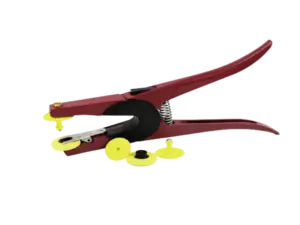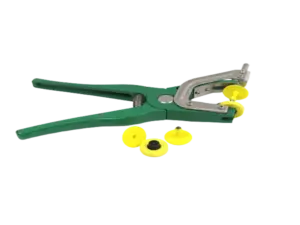Introduction:
Ear tags play a crucial role in the livestock industry, serving as a means of identification, management, and traceability. To effectively apply ear tags, using an ear tag applicator is essential. Using this tool correctly is paramount to ensure the well-being of the animals. It is critical to the accuracy of the identification process. In this guide, we will delve into the step-by-step process. We will know how to use ear tag applicators correctly. We also emphasize vital considerations and best practices.
How To Use Ear Tag Applicator Correctly?

Choosing the Right Ear Tags
Before delving into the proper use of an ear tag applicator, starting with the right ear tags is crucial. Different types of ear tags are available, including visual and electronic tags. Selecting the appropriate tag for your specific needs is essential. Consider factors such as the type of livestock, regulatory requirements, and your management goals.
Familiarizing Yourself with the Applicator
Ear tag applicators come in various designs. But most share common components such as handles, jaws, and a mechanism for tagging. Before use, familiarize yourself with the specific applicator model you have. Read the manufacturer’s instructions and become comfortable with the tool’s features. It ensures you understand how to load tags properly and operate them.
Preparing the Livestock
Proper preparation of the animals is a crucial step in ensuring a smooth and stress-free tagging process. Secure the animal in a suitable restraint. Minimize the risk of injury to both the animal and the operator. Ensure the ear to be tagged is clean and dry. Because dirt or moisture can affect the tag’s adhesion and potentially lead to complications.
Loading the Ear Tag
Before applying the ear tag, ensure it is loaded correctly into the applicator. Follow the manufacturer’s instructions for your specific model. Typically, this involves placing the tag securely in the applicator’s jaws. It ensures it is positioned correctly for accurate placement on the animal’s ear.
Positioning the Applicator
Approach the animal calmly and confidently, holding the applicator firmly. Position the applicator over the designated ear. This is to ensure the tag’s placement aligns with the recommended location. It helps in optimal visibility and readability. Maintain a steady hand and avoid sudden movements that may startle the animal.
Applying the Ear Tag

Once the applicator is properly positioned, exert steady and even pressure to close the jaws around the ear. The tag should be applied smoothly, piercing the ear tissue without causing excessive trauma. Quick and precise application minimizes stress on the animal. It also reduces the likelihood of complications such as infection or tag loss.
Checking for Proper Placement
After applying the ear tag, inspect it to ensure it meets industry standards. It should also meet the regulatory requirements. The tag should be securely attached to the ear, with no signs of tearing or damage to the surrounding tissue. Properly placed ear tags contribute to accurate identification and effective management practices.
Post-Tagging Care
After tagging, monitor the animals for any signs of distress or discomfort. Provide appropriate post-tagging care. It may include applying antiseptic solutions to the tagged ear to prevent infection. Keep a close eye on the tagged animals in the subsequent days to ensure the tags remain securely attached and that there are no adverse reactions.
Recording and Documentation
Accurate record-keeping is a crucial aspect of livestock management, and ear tagging is a key component. Immediately record the unique identification number associated with each ear tag. Link it to relevant information such as birthdate, parentage, and health records. This documentation is invaluable for traceability, breeding programs, and overall herd management.
Regular Maintenance and Calibration
To ensure ongoing effectiveness, perform regular maintenance and calibration checks. Clean the applicator after each use to prevent the buildup of dirt or debris that could compromise its functionality. Follow the manufacturer’s guidelines for calibration. It ensures the applicator delivers consistent and accurate results.
FAQs
1. Why is it essential to use an ear tag applicator for livestock management?
Ear tag applicators are crucial for proper livestock identification. They enable farmers to manage their herds effectively. Identification is vital for traceability, breeding programs, and health management. An applicator ensures accurate and secure attachment of ear tags. It contributes to the overall success of livestock operations.
2. How do I choose the right ear tags for my livestock?
The choice of ear tags depends on factors such as the type of livestock, regulatory requirements, and management goals. Consider whether visual or electronic tags are more suitable, and select tags that meet industry standards. It’s essential to choose tags that are durable, visible, and compatible with the chosen ear tag applicator.
3. What precautions should be taken when preparing livestock for ear tagging?
Proper preparation of animals is crucial to minimize stress and ensure a smooth tagging process. Secure the animal in a suitable restraint. Ensure the earmark location is clean and dry, and avoid excessive force or sudden movements. Do nothing that startles the animal. Adequate preparation contributes to a safer and more efficient tagging experience.
4. How to use ear tag applicators correctly and do not cause harm to the animal?
Proper positioning of the applicator and steady pressure during application are important. Also, quick and precise tagging is essential for minimizing stress and avoiding trauma to the animal. Regularly check the tagged ear for proper placement. Ensure the tag is securely attached without signs of tearing or damage to the surrounding tissue.
5. What post-tagging care is recommended for the welfare of the animals?
After tagging, monitor the animals for any signs of distress or discomfort. Apply antiseptic solutions to the tagged ear to prevent infection. Keep a close eye on the animals in the subsequent days to ensure the tags remain securely attached. Prompt post-tagging care contributes to the well-being of the animals. It helps prevent potential complications.
Conclusion:
Using an ear tag applicator is a fundamental skill for any livestock operator. By following these guidelines, individuals can enhance the accuracy of identification. It contributes to effective herd management and ensures the well-being of the animals. Remember to prioritize animal welfare throughout the tagging process. Stay informed about any regulatory requirements or industry standards. Otherwise, it may impact your tagging practices. Careful consideration and attention to detail of an ear tag applicator is a valuable tool. It helps in the overall success of a livestock operation.
